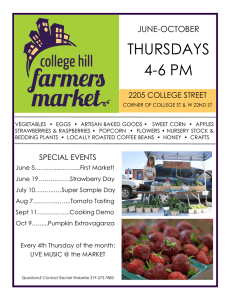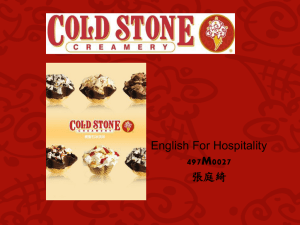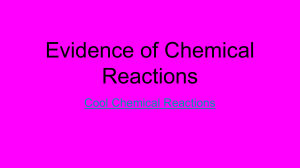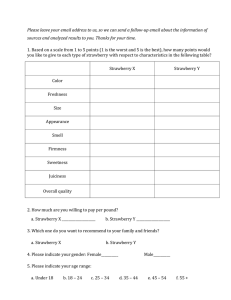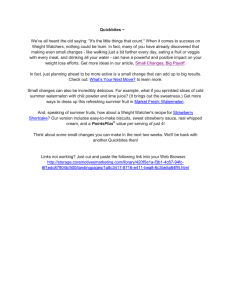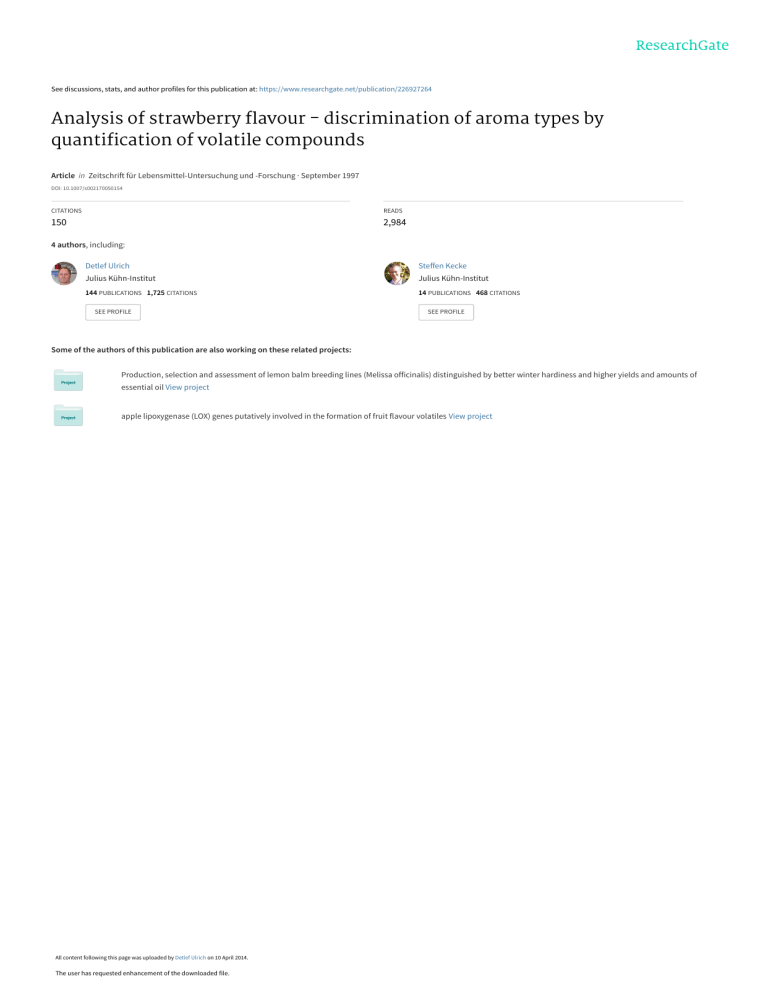
See discussions, stats, and author profiles for this publication at: https://www.researchgate.net/publication/226927264 Analysis of strawberry flavour - discrimination of aroma types by quantification of volatile compounds Article in Zeitschrift für Lebensmittel-Untersuchung und -Forschung · September 1997 DOI: 10.1007/s002170050154 CITATIONS READS 150 2,984 4 authors, including: Detlef Ulrich Steffen Kecke Julius Kühn-Institut Julius Kühn-Institut 144 PUBLICATIONS 1,725 CITATIONS 14 PUBLICATIONS 468 CITATIONS SEE PROFILE SEE PROFILE Some of the authors of this publication are also working on these related projects: Production, selection and assessment of lemon balm breeding lines (Melissa officinalis) distinguished by better winter hardiness and higher yields and amounts of essential oil View project apple lipoxygenase (LOX) genes putatively involved in the formation of fruit flavour volatiles View project All content following this page was uploaded by Detlef Ulrich on 10 April 2014. The user has requested enhancement of the downloaded file. Z Lebensm Unters Forsch A (1997) 205: 218 – 223 Springer-Verlag 1997 O R I G I N A L PA P E R Detlef Ulrich ? Edelgard Hoberg ? Adolf Rapp Steffen Kecke Analysis of strawberry flavour ± discrimination of aroma types by quantification of volatile compounds Received: 13 November 1996 / Revised version: 4 February 1997 AbstractmOver a period of 3 years, the essential volatile compounds of several strawberry varieties were analysed by gas chromatography, gas chromatography-olfactometry and mass spectrometry. In general, a strong variability in the dependence of the amount of these compounds on the ripening stage, climate and location was found, nevertheless, the key compounds of the aroma showed typical, genetically determined basic patterns. The quantification of the key aroma compounds in cultivated and wild strawberries resulted in a definition of aroma types which corresponded with the sensory evaluation. These aroma types can be used to establish a criterion for the selection of quality in strawberry breeding. Key wordsmStrawberry ? Flavour ? Aroma ? Volatiles ? Gas chromatography-olfactometry ? Sensory evaluation ? Plant breeding Introduction Strawberries are cultivated in nearly all countries of the world and are one of the most popular fruits that are consumed as fresh, conserved or manufactured products. The actual number of strawberry varieties is immense and every year new varieties come into trade and cultivation. The German Federal Office of Plant Varieties tests a collection of about 200 strawberry varieties every year. Because of its typical aroma, the strawberry has always been a favoured object in aroma analysis. In addition, the chemical basis of the strawberry aroma has been examined D. Ulrich ( ) ? E. Hoberg ? S. Kecke Federal Center for Breeding Research on Cultivated Plants, Institute for Quality Analysis, Neuer Weg 22/23, D-06484 Quedlinburg, Germany A. Rapp Institute for Grapevine Breeding Geilweilerhof, D-76833 Siebeldingen, Germany in depth [1]. The flavour industry is able to supply synthetic aromas for the flavouring of many types of foods, as well as pharmaceutical and other products. One of the key compounds of the strawberry aroma, 2,5-dimethyl-4-hydroxy3(2H)-furanone (Furaneol, DHF) [2], represents one of the most important synthetic flavour in terms of mass and value. On the other hand, the sensory quality of traded strawberries is often criticized by consumers. Throughout this century the predominant aim of plant breeding has been to increase not the sensory quality, but rather parameters such as yield, habitat and the ability to withstand storage, transport and processing. As is the case for other fruit and vegetable species, only the old cultivated varieties have excellent sensory characteristics [3, 4]. Plant breeding and quality control demand measurement of objective parameters for the assessment of sensory quality. The aim of the work published here was to characterize the chemical profile of the strawberry aroma, with special regard being given to the application of aroma analysis to selection in plant breeding. The flavour substances of strawberries, especially the volatile compounds, have been studied extensively. In the literature, more than 360 volatile compounds have been reported [1]. As well as sugars and acids about 15–20 volatile compounds are important for sensory perception [5–8]. In Table 1 the aroma compounds are summarized according to their gas chromatographic retention indices on a wax column. The contribution of these compounds to the total aroma impression is the aroma value, which is defined as the quotient of concentration and odour thresholds. It varies within relatively large ranges depending on the individual variety [8–13]. Staudt et al. [14] attempted to characterize wild species by quantification of volatile compounds, especially the esters. In the paper of Larsen et al. [6] two types of cultivated strawberries are distinguished by their high or low ester content. Another important direction in strawberry breeding is concerned with the introduction of the typical “wood strawberry flavour” into cultivated varieties by crossing genotypes of Fragaria ananassa Duch. and Fr. vesca L., 219 Fig. 1mSensory profiles of four strawberry varieties with different aroma characters and popularities. The values are given as the average of over 3 years. Wild strawberry: 1 - Fragaria vesca L.; cultivated strawberries (Fr. ananassa Duch.): 2 - Polka, 3 - Elsanta, 4 - Senga Gourmella. Description of the sensory parameters – Smell: 1, green (grassy like cis-3-hexenal); 2, aromatic (typical cultivated or wild strawberry); 3, fruity (ester-like); 4, flowery (like β-ionon); Taste: 5, sweet; 6, sour; 7, flavour (intensity of overall flavour); 8, stale; 9, ripe; 10, popularity which are normally unable to cross-pollinate. By using these parents Fr. vescana was recombinated after extensive breeding experiments [15, 16]. A simple sensory comparison of the aromas of Fr. ananassa Duch. and Fr. vesca L. types indicates significant differences in the chemical composition which, to date, have not been clearly interpreted. A precondition of using instrumental-analytical methods for breeding and quality control is the determination of the differences between strawberry species in terms of their chemical composition. Materials and methods Material Four European cultivated strawberry varieties and one wild species were harvested from 1993 to 1995 in the experimental garden of the Federal Center of Breeding Research on Cultivated Plants. Only fully ripe fruits typical of the respective varieties were sampled. The characteristics of the varieties discussed correspond to those in [17]. Wild strawberry (“wood strawberry”): A – Fr. vesca L., local clone. Cultivated strawberries (Fr. ananassa Duch.; “pineapple strawberry”): B – “Mieze Schindler”; breeder, Professor Schindler, Dresden; origin, crossing from “Lucida perfecta” and “Johannes Müller”; registration in the 1930s; C – “Polka”; breeder, IVT Wageningen, The Netherlands; origin, crossing from “Induka” and “Sivetta”; registration in 1988; D – “Elsanta”; breeder, IVT Wageningen, The Netherlands; origin, crossing from “Gorella” and “Holiday”; registration in 1982; E – “Senga Gourmella”; breeder, von Sengbusch; registration in 1971. Fig. 2mGas chromatography-olfactometry: comparison of flavour dilution (FD) chromatograms. Sensory impressions with FD-factors below 2 and the “green” notes are excluded from the chromatogram. Compounds numbered 9a and 18a are unknown and mixed. Normally it took 3 h from harvest to testing. The sensory evaluation of strawberries was carried out by a trained panel consisting of 15 members with five samples per session. After collecting a choice of altogether 11 sensory features the quantification was made. The characteristics were defined both verbally and in comparison with reference substances. The panellists quantified the features on a nongraduated 10-cm-long linear scale. Every variety was tested six times in the experimental period. Instrumental analysis Sample preparation. Fruits were washed and sepals dissected. Then, 200 g fruits and 200 ml of a 20 mass% NaCl solution were homogenized for 2 min in a Waring blender. The centrifugation at 3500 g and 4 °C (30 min) was followed by addition of the internal standard, 2,6dimethyl-5-hepten-2-ol (0.1 ppm v/v to the supernatant of the centrifuged material). Following this, 200 ml of the supernatant was extracted for 20 h at a water bath temperature of 27 °C with trichlorofluoro methane (Merck No. 818 749, boiling point 23 °C, 1x distilled). Gas chromatography-olfactometry. Hewlett-Packard 5890 A; injector temperature 180 °C; split 10 ml. Column: HP-INNO wax 30 m × 0.32 mm ID/0.5 µm; 2 ml hydrogen/min; temperature programme: 50 °C to 180 °C at 3 °C/min, FID detector 250 °C. Split of carrier gas: 33% to FID and 66% to sniffing port. For the aroma extract dilution analysis the extracts were stepwise diluted with solvent (freon) in a geometrical line [18]. The gas chromatography-olfactometry analysis was repeated for the five varieties every year. The panellists who carried out the olfactory analysis were specially trained members of the above-mentioned sensory panel. Sensory evaluation The same sample was used for instrumental and sensory analyses. The berries were washed and, after dissection of sepals, divided into four Gas chromatography. Hewlett-Packard 5890 A; injector temperature 180 °C; split 40 ml. Column: HP-INNO wax 60 m × 0.32 mm ID/ 0.5 µm; 2 ml hydrogen/min, temperature programme: 50 °C to 180 °C 220 Table 1mAroma compounds in the strawberry. Out of the 120 identified compounds the 23 listed are quantified by the method given in the text. The substances 2, 3, 6, 8, 10 – 14, 16, 17 and 19 were selected for Peak no. the aroma patterns in Fig. 3. References for threshold values: [1, 5, 6, 23, 24]. [DMF 2,5-Dimethyl-4-methoxy-3(2H)-furanone, DHF 2,5dimethyl-4-hydroxy-3(2H)-furanone] Retention index Compound Threshold in water (ppb) Sensory description 1 2 3 4 5 940 945 977 1006 1120 Pentanone-2 Methyl butanoate Ethyl butanoate Butyl acetate Heptanone-2 50 59 0.13 5000 50 Thinner, acetone Fruity, ester-like, green Fruity, ester-like, sweet Thinner Meaty 6 6a 7 8 9 10 1125 1147 1164 1183 1398 1573 Methyl hexanoate (Z)-3-Hexenal (E)-2-Hexenal Ethyl hexanoate (Z)-3-Hexen-1-ol Linalool 70 0.25 17 3 70 6 11 12 13 14 15 15 a 1625 1669 1711 1882 1943 1957 DMF Butanoic acid 2-Methyl butanoic acid Hexanoic acid 2-Phenyl ethanol β-Ionone 0.03 240 180 3000 1100 0.007 Fruity, caramel, green Buttery Fruity, buttery Unpleasant Flowery, rose Floral, crude, violet 16 16 a 17 18 18 a 19 2042 2063 2123 2143 2163 2216 DHF Octanoic acid γ-Decalactone Eugenol δ-Decalactone Methyl anthranilate 0.04 8800 50 11 160 3 Caramel, sweet Unpleasant, fatty Fruity, lactone-like, cocos Spicy, nutmeg Lactone-like Aromatic, fruity, sweet, soap Table 2mKey compounds of strawberry aroma. Values are relative concentrations of aroma key compounds. The areas of the volatile compound peaks were normalized by the area of internal standard Peak no. Compound Methyl butanoate Ethyl butanoate Methyl hexanoate Ethyl hexanoate Linalool 11 12 13 14 16 DMF Butanoic acid 2-Methyl butanoic acid Hexanoic acid DHF 17 19 γ-Decalactone Methyl anthranilate peak. The data are given as average of a 3-year trial, with 38 observations. Varieties: A – Fragaria vesca L., B – Mieze Schindler, C – Polka, D – Elsanta, E – Senga Gourmella (n. d. Not detectable) Relative concentration of key aroma compounds in variety: A 2 3 6 8 10 Fruity, ester-like Green, grassy Green, fatty Fruity, ester-like, green apple Grassy, green Flowery, sweet B C D E 0.4 2.1 0.1 0.5 0.2 5.3 2.0 1.2 1.4 0.1 7.9 3.5 0.8 0.6 0.3 0.5 0.1 0.4 0.1 0.8 0.3 50.1 0.1 50.1 1.1 19.3 0.2 0.8 2.1 2.9 0.1 2.2 7.1 45.6 8.2 6.0 0.4 3.9 8.4 2.4 4.3 6.7 8.6 31.2 2.5 34.4 5.5 7.2 94.3 5.4 2.0 5.5 0.1 1.3 0.2 n.d. 8.0 n.d. 77.5 n.d. at 1.5 °C, FID detector 250 °C. The quantification was carried out by comparison of areas of the peaks to those of the internal standard (2,6dimethyl-5-hepten-2-ol, ROTH No. 9237.1). Results and discussion GC/MS. Hewlett-Packard MSD 5972 with HP 5890 Series 2 plus, data base NBS75 K and Wiley138. Column: INNO-wax 60 m × 0.32 mm ID/0.5 µm; 2 ml helium/min; temperature programme: 50 °C to 180 °C at 1.5 °C/min. Between 1993 and 1996 the authors examined altogether 27 European cultivated strawberry varieties and 20 wild species. For discussion in this paper five species from the years 1993–1995 were selected, which represent the typical set of sensory and chemical features. Statistical calculation. Programme SAS 6.08; Proc RANK, Proc CLUSTER. Procedure: the metric data were standardized and processed by cluster analysis (method “average linkage”). Sensory profiles Figure 1 shows the sensory profiles of four strawberry species. The data represent the average of 3 years. The 221 Fig. 3mAroma pattern of four different strawberry varieties. Aroma value versus number of volatile compounds listed in Table 1. The compounds with “green” characters (Z)-3-hexenal (6a), (E)-2-hexenal (7) and (Z)-3-hexenol (9) are excluded. The data shown are the average of 38 observation from 3 years wild species Fr. vesca L. differs notably from the cultivated varieties because it has an aromatic and flowery odour (feature 2 and 4). After long-term trials at the German Federal Office of Plant Varieties [17] and the Federal Center of Breeding Research, the variety “Polka” has been shown to be a strawberry with a good or very good taste, which is reflected in its sensory profile by high values for flavour and popularity. The varieties “Elsanta” and “Gourmella” compare badly in all of these features. Although sensory sensations are also influenced by parameters other than aroma compounds, the strawberry odour and taste impressions recorded in several growing periods were relatively stable and clearly different. Because of the limited number of samples and the changing weather conditions the sensory results are not statistically significant but show trends according to year-long trials of other investigators [17]. Gas chromatography-olfactometry The olfactometric analysis of strawberries led to the characterization of five basic sensory impressions of strawberries: fruity, green, caramel, lactone-like and buttery [5, 8]. Strawberry is a fruit with a very intensive aroma which is based on its high content of chemical substances. Concentrated extracts therefore lead to a high number of odour impressions in gas chromatography-olfactometry analysis. Figure 2 summarizes the flavour-dilution chromatograms (FD-chromatogram) of four varieties. In order to get a rapid survey, weakly intensive odour impressions with FD-factors below 2 are excluded. Green odour notes based on hexenals and hexenols have an exceptional quality. In particular, (Z)-3-hexenal, with its very low threshold value of 0.25 ppb, contributes essentially to the fresh aroma impression and is necessary for the positive strawberry aroma [5]. Thermally processed or frozen berries lack such “green” components and differ significantly from fresh fruits [5, 7, 11]. Precursors of green components are multiple-unsaturated fatty acids [19, 20] which are decomposed by enzymes. Investigations of the bell pepper demonstrate that the formation of these substances only starts after destruction of cell tissue in the receptacles during homogenization [21]. Observations by Luning et al. show that, in contrast to the situation for other volatile compounds, the quantity of “green” components is highly varied within one variety and that an obvious relationship exists between the ripening stage of the fruits and the method of sample preparation.This is also the reason why the “green” odour impressions are not represented in the FD-chromatograms. The varieties evaluated contain all the compounds that give rise to the basic sensory impressions, but in different quantities. The wood strawberry Fr. vesca L. differs from the cultivated types in that it contains a very aromatic, plainly recognizable woodstrawberry-like semivolatile compound. It was identified as methylanthranilate, reported previously by Hirvi and Honkanen [9]. This component was detected first in the nearly 50-year-old “Mieze Schindler” (see Table 2). “Polka” is distinguished from all other varieties by virtue of the fact that it smells strongly of ester-like compounds. In “Elsanta” this group is weakened and is completely absent from “Senga Gourmella”, which, in addition, contains an off-flavour (hexanoic acid). Gas chromatography The aroma value was calculated by dividing the relative concentrations of volatile compounds (in area %) by the corresponding odour threshold value in water [18], as indicated in the literature (see Table 1). Figure 3 shows the aroma patterns of the four typical varieties mentioned above. The aroma patterns of the four varieties correlate sufficiently with the sensory impressions made in the olfactometry experiments. In all tested strawberries the substances 2,5-dimethyl-4-methoxy-3(2H)-furanone (Mesifuran, DMF) and 2,5-dimethyl-4-hydroxy-3(2H)-furanone (Furaneol, DHF) have the highest aroma values. Wood strawberry is characterized by its medium to high aroma values for methylanthranilate. “Polka” is notable because of its high quantities of butanoic and hexanoic acids esters. The sensorially less preferable varieties contain less of the esters and more γ-decalactone and hexanoic acid. The absence of esters in conjunction with high concentrations 222 Fig. 4mCluster analysis of a 3-year trial with five strawberry varieties and 38 observations. Analysis of 23 volatile compounds by GC after liquid-liquid extraction. Wild strawberry: 1 – Fragaria vesca L. Cultivated strawberries (Fr. ananassa Duch.): 2 – Mieze Schindler, 3 – Polka, 4 – Elsanta and Senga Gourmella. (OBS Number of observation, D euclidean distance) of DMF, DHF and hexanoic acid seems to result in an aroma impression which is perceived as unpleasant. Statistical analysis The relative concentrations of aroma substances for the five varieties harvested from 1993 to 1995 were calculated by cluster analysis. The results are shown in Fig. 4. The marked clusters of volatile compounds composition conform with the sensorially distinguishable genotypes. Fig. 5mAroma types of strawberries. [MA Methylanthranilate, DHF 2,5-dimethyl-4-hydroxy-3(2H)-furanone] other positive characters such as a good tolerance to storage and shipping. The results discussed allow further conclusions to be drawn that are relevant to plant breeding. The instrumental analysis can support an effective selection for sensory quality. From the generally high number of descendants, seedlings with positive aroma patterns can be selected, e.g. ester-rich or methylanthranilate-rich types. Therefore, applied breeding should use effective analytical methods (rapid methods). One of the opportunities already used for analysis of strawberry aroma is gas chromatography in combination with solid-phase microextraction [22]. AcknowledgementsmThe authors wish to thank M. Dießner, H. Elstner, S. Eunert and H. Hastrich for their technical assistance. Strawberry aroma types The results gained from the instrumental analysis of the five typical strawberry varieties discussed in this paper allow the conclusion that distinct aroma types can be defined (Fig. 5). This is supported by the sensory analysis trends mentioned above. A very important role is played by methylanthranilate, which is responsible for the typical character of the wood strawberry (Fr. vesca L.) aroma, which is characterized by an intensive spicy-aromatic and flowery note. All genotypes investigated can be subdivided into a methylanthranilate-containing and methylanthranilate-free types. As well as some wild species “Mieze Schindler” is a methylanthranilate-containing type. For decades this old cultivar has been known as one of the most favoured strawberries in Germany. Depending on climatic conditions “Mieze Schindler” contains low to medium concentrations of methylanthranilate. In contrast, the methylanthranilate-free group is divided in a sensorially pleasant group (ester-type) and a less pleasant group (DHF-type). Fr. virginiana L. – one of the parental genotype of Fr. ananassa Duch., with a fresh and fruity aroma – can be assigned to the ester-type. The third group, the DHF-type, contains varieties with medium to poor flavour; however, often this flavour is combined with References 1. Maarse H (1991) Volatile compounds in foods and beverages. Dekker, New York 2. Sen A, Schieberle P, Grosch W (1991) Lebensm Wiss Technol 24: 364–369 3. Alston FH (1992) In: Patterson RLS (ed) Bioformation of flavours. The Royal Society of Chemistry, Cambridge 4. Paydas KS, Kaska N, Agar IT (1996) Gartenbauwissenschaft 61: 96–102 5. Fischer N, Hammerschmidt FJ (1992) Chem Mikrobiol Technol Lebensm 14: 141–148 6. Larsen M, Poll L, Olsen E (1992) Z Lebensm Unters Forsch 195: 536–539 7. Schieberle P (1994) Heat-induced changes in the most odouractive volatiles of strawberries. In: Maarse H, Van der Heij DG (eds) Trends in flavour research. Elsevier, Amsterdam 8. Ulrich D, Rapp A, Hoberg E (1995) Z Lebensm Unters Forsch 200: 217–220 9. Hirvi T, Honkanen E (1982) Z Lebensm Unters Forsch 175: 113– 116 10. Douillard C, Guichard E (1989) Sci Aliments 9: 53–76 11. Douillard C, Guichard E (1990) J Sci Food Agric 50: 517–531 12. Schreier P (1980) J Sci Food Agric 31: 487–494 13. Bricout J et al. (1990) Int Fruchtsaft Union 21: 325–331 14. Staudt G, Drawert F, Tressl R (1975) Z Pflanzenzücht 75: 36–42 223 15. Gruber F, Bauer R, Kappert H, Rudorf W (1962) Fragaria L. – Subgenera: Fragaria ananassa Duch. und Fragaria vesca semperflorens Duch. Handbuch der Pflanzenzüchtung, Band VI. Parey Berlin 16. Bauer A (1994) Vortr Pflanzenzüchtung 27: 129–133 17. Beschreibende Sortenliste, Beerenobst (1995) Bundessortenamt. Landbuch, Hannover 18. Grosch W (1990) Chem Unserer Zeit 24: 82–89 19. Ohloff G (1990) Riechstoffe und Geruchssinn. Die molekulare Welt der Düfte. Springer, Berlin Heidelberg New York View publication stats 20. Ullrich F, Grosch W (1987) Z Lebensm Unters Forsch 184: 277– 282 21. Luning PA, de Rijk T, Wichers HJ, Roozen JP (1994) J Agric Food Chem 42: 977–983 22. Ulrich D, Eunert S, Hoberg E, Rapp A (1995) Dtsch Lebensm Rundsch 91: 349–351 23. Honkanen E, Hirvi T (1990) The flavour of berries. In: Morton ID, Macleod AJ (eds) Food flavours. Part C. The flavours of fruits. Elsevier, Amsterdam 24. Larsen M, Poll L (1992) Z Lebensm Unters Forsch 195: 120–123
